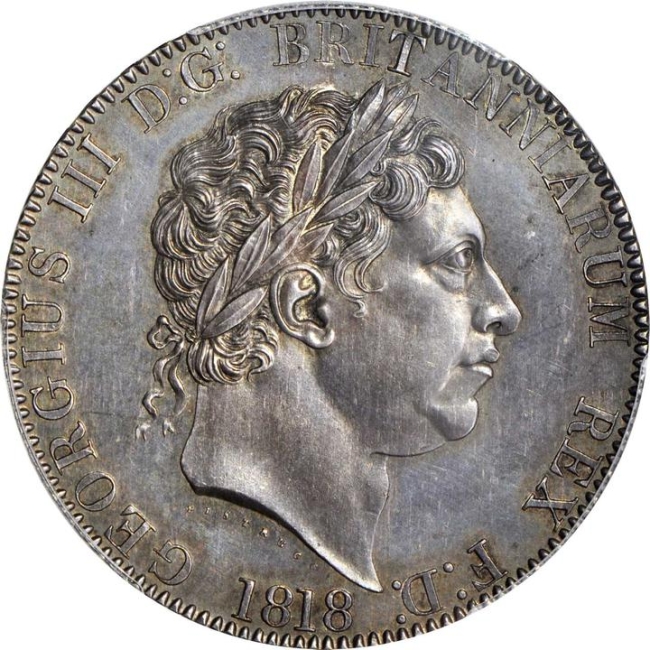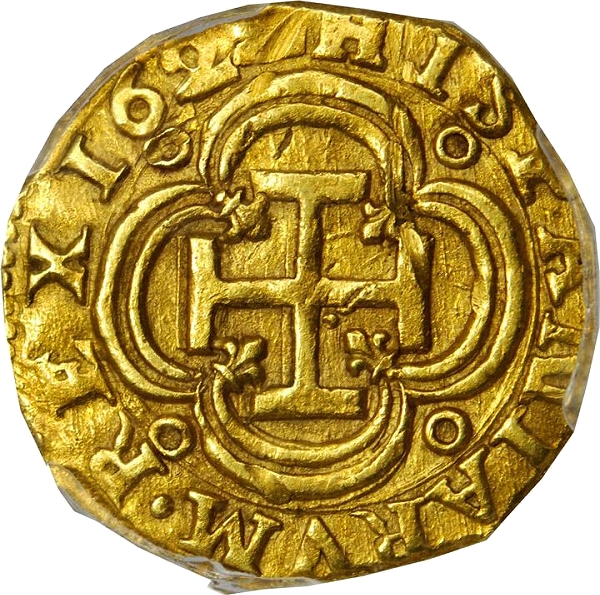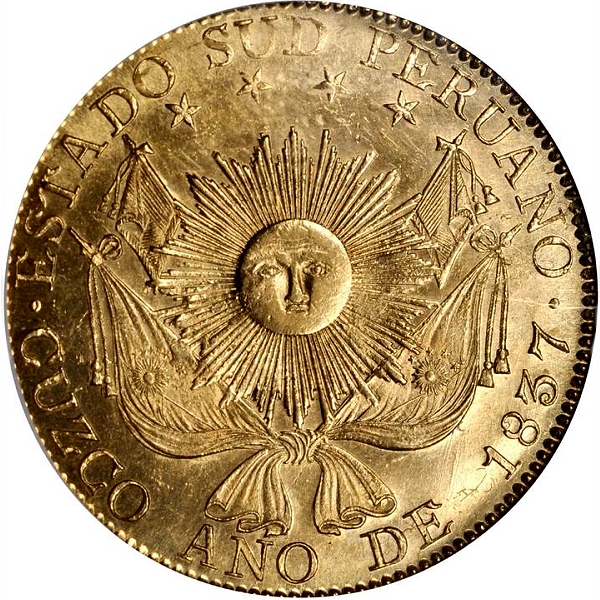Below are some of the highlights from the upcoming Stack’s Bowers auction sessions during the NYINC show in New York City. There is a treasure trove of Colombian coins and paper money from the Eldorado Collection
1923 COLOMBIA 5 Pesos Banco de la República Billete Provisional banknote Overprinted on Casa de Moneda de Medellín. PMG Choice Very Fine 35.
Provenance: From the Eldorado Collection of Colombian Paper Money
From this exceedingly rare Provisional series. Overprinted on the back of a ABNCo. printed Casa de Moneda de Medellín, this was last cataloged and sold in the Amon Carter, Jr. sale in December 1997 (lot 522 and illustrated in the plates). That was over 20 years ago. It is an incredible note believed to be the finest from the series. The ABNCo. host type is beautifully designed with Foringer adapted vignette at the center. Brown and blue multi-color tinting on the face. The brown back has a very strong overprint. Noted by PMG as previously mounted. Precise viewing is needed to find those marks. The paper originality is superb. One of the key types in the entire collection. A prize Latin American and world note rarity.
LOT 10044 – Estimate: $6,000 – $9,000.
1818 GREAT BRITAIN. Pattern Crown George III PCGS PROOF-64
Provenance: Likely Ex: Glendining & Co. Sale, October 1962, lot# 121.
A pattern issue for an unadopted type. This pattern features larger lettering in the obverse legend and the back of the truncation is chamfered sharply. The reverse differs from the standard type with fine horizontal lines within the garter. Obverse: “GEORGIUS III D: G: BRITANNIARUM REX F: D: 1818” (George III By the Grace of God, of Britain, King, Defender of the Faith) Laureate head of King George III facing right, “Pistrucci” below bust; Reverse: “HONI . SOIT . QUI . MAL . Y . PENSE .” (Evil to him who evil thinks) Saint George and the Dragon, the ground line occupies the whole space between the garter which surrounds the design, garter ruled with fine horizontal lines, “Pistrucci” in exergue. Edge: “DECUS ET TUTAMEN ANNO REGNI LVIII” (An ornament and a safeguard, in the 58th year if our reign) in raised letters with rose stops.
According to L. Forrer author of “Biographical Dictionary of Medallists” London 1909 vol. IV pg. 589-591, who was supplied extensive documentation from Pistrucci’s family, namely Major Serafino Poggioli, husband of his granddaughter. During the new coinage manufacture in 1816 Pistrucci was employed at the mint as an outside assistant. On 22 September 1817 Thomas Wyon died and Pistrucci was offered the post of Chief-engraver. Since he was a foreigner this was highly contested. While at the mint he made a friend by the name of W.R. Hamilton who was a staunch defender of him. Pistrucci performed his duties as Chief-engraver, though the office was kept in abeyance at least until 1828 when a compromise was made. The second engraver at the mint, William Wyon, was made Chief-engraver and Pistrucci was designated as “Chief Medalist”. Among his opponents were Mr. Hawkins, the Keeper of coins and Antiquities at the British Museum, and Nicholas Carlisle, Secretary of the Society of Antiquaries. The latter who practically accused Pistrucci of extorting money from the Master of the Mint. Of course this was refuted by Mr. Hamilton who ended his relationship with Mr. Carlisle. In a letter from W. D. Haggard to Mr. Carlisle that was in the possession (as of 1909) of Messrs. Spink & Son Ltd. occurs the passage “Wyon could no more cut the beautiful gem in which Pistrucci excels than could Pistrucci engrave dies equal in beauty to those of Wyon”. Hawkins further states that “Pistrucci’s work is beautifully executed, and its appearance was hailed with pleasure, and with the hope, that those who were in authority were weaning themselves from their attachment to armorial bearings, and becoming alive to the beauty, interest, and importance of classical reverse”.
It is clear that the present specimen is truly a work of art with fantastic style, execution and is a testament to the artistic ability that Pistrucci possessed. Lovely deep old cabinet tone throughout with hints of blue, red and golden hues when tilted in the light. An important offering of a magnificent Pistrucci pattern.
LOT 20359 – Estimate: $70,000 – $90,000.
1622 COLOMBIA 2 Escudos Cartagena mint Phillip III AU-58 (PCGS)
The Famous 1622 Cartagena 2 Escudos Discovery Coin. The First Known Specimen of the First Gold Coin of the New World
Provenance: From the Eldorado Collection of Colombian and Ecuadorian Coins. Acquired from Kurt Spanier at the 1982 American Numismatic Association convention in Boston, August 1982.
This is the most famous of the eight known examples of this most historic gold cob issue, the very first to have been struck in the New World. This piece has served as the plate coin in more references than all the other known specimens combined.
The surfaces are frosty yellow gold with no encrustation or major flaws. The centering is better than all the other known examples. The obverse shows a bold and complete shield, well struck S / F mintmark, the lower portion of all letters of PHILLIPPVS III, and the II denomination. A mark on the denomination and a similar nick on the shield corner next to S are the only minor flaws. The reverse is also remarkably bold and well centered, with 162 complete and the lower half of the 2 readily apparent despite an old abrasion there. The legend HISPANARIVM REX is absolutely complete, and the central cross is as bold as could be hoped for.
There is no doubt that this is the best and most widely recognized of the survivors of this issue. Herman Blanton ranked this #1 on his census, published in Numismatics International in 2014 and on his website since. The Ortiz-Norweb specimen has a more complete date, which resulted in it bringing $32,000 at its last offering in 1997. All eight known examples came from the wrecks of the Santa Margarita and the Nuestra Señora de Atocha, which both sailed with the 1622 treasure fleet and sank off the coast of Florida. One of the eight recorded specimens is permanently off the market: the Lasser coin, which was donated to the Colonial Williamsburg Foundation in 2010.
With only seven examples in private hands, and the historic importance of being the very first gold coin struck in the New World, the 1622 2 Escudos of Cartagena is a classic and widely desired rarity. Every onza, every double eagle, literally every gold coin struck in this hemisphere can trace its lineage back to this humble beginning. This specimen is ranked as number 1 in the Herman Blanton census and is generally considered the best centered and most desirable specimen. It is among the highlights of this cabinet. ($15,000-30,000)
PCGS Population: 1, none finer.
LOT 11004 – Estimate: $15,000 – $30,000.
1837 PERU 8 Escudos Cuzco Mint. NGC MS-63
Fabulous Sun Face 8 Escudos – South Peru existed as a separate entity for only three years, and yet in this short time span some of the most beautiful coinage to ever be created in South America came to life. The compelling design elements of coinage from South Peru, combining much of the heritage of Peru into a single codified representation, have held great attraction for numismatists ever since these coins were first created. The coin offered here features the earlier “ESTADO SUD PERUANO” legend on the obverse along with four stars representing the four constituent departments of South Peru, which were comprised of Ayacucho, Cuzco, Arequipa and Puno. The reverse depicts features of South Peru including a volcano and a Inca fortress. A spectacular example, with great strike details and brilliant luster.
LOT 21286 – Estimate: $14,000 – $18,000.
1759 COLOMBIA 8 Reales. Santa Fe de Nuevo Reino (Bogotá) mint. Ferdinand VI (1746-1759) MS-62 (PCGS)
Provenance: From the Eldorado Collection of Colombian and Ecuadorian Coins.
A stellar example of the first milled coinage struck in Colombia. The surfaces retain good frost and luster, chiefly brilliant with hints of gold and pale blue toning atop the reverse. Both sides are struck with an alignment toward 12:00, with long denticles at the base that frame the periphery from 1:00 to 9:00 on the obverse and 2:00 to 10:00 on the reverse. Trivial hairlines are visible, but no major marks, just a nick above the left pillar and a tiny dig right of the floret above the assayer on the reverse. A short linear scratch is hidden right of the 9 in the date. The strike is sharp, though the planchet shows a small patch of inherent roughness between 17 of the date. The reverse shows light reflectivity. An internal die break is seen on the shield border below the lower right castle, and other identifying die flaws are seen right of the shield and below RD of FERD. This reverse is one of three identified for the date and is different from the reverse seen on the following lot.
Among the six mints, all in the New World, that coined Pillar 8 Reales, Santa Fe and Santiago offer type collectors the greatest challenge. Just four issues were coined in Colombia, all bearing the NR mintmark: 1759, 1760, 1762, and 1770. The 1770 issue was unknown until about 10 years ago, when 14 pieces (all Mint State) were found in a church cornerstone in Bogotá. Two examples dated 1762 are known, and two 1760-dated pieces are recorded, with rumors of a third. Specimens dated 1759 are only slightly more numerous than those of 1770, but only two are known in Mint State, including this one. The 1759 is also the only one of the Colombian Pillar 8 Reales to have been coined under Ferdinand VI, making it a one-year type coin.
One of only three examples of this issue graded by PCGS, this is a marquee highlight in this collection and a contender for finest known of this issue. NGC has graded only two, including the only other Mint State example known: the F.C.C. Boyd – 1975 ANA – Lissner MS-62 that brought $114,950 in August 2014.
LOT 12001 – Estimate: $20,000 – $40,000.









